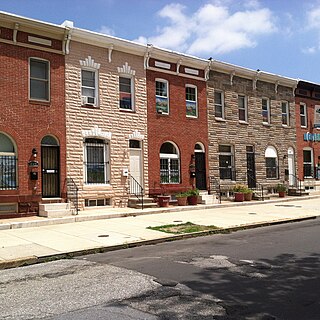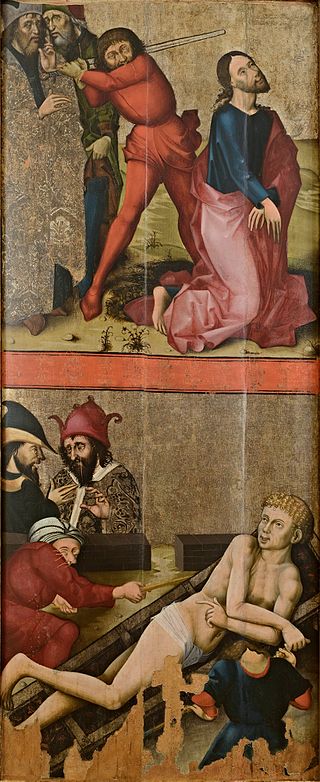Related Research Articles

International Gothic is a period of Gothic art which began in Burgundy, France, and northern Italy in the late 14th and early 15th century. It then spread very widely across Western Europe, hence the name for the period, which was introduced by the French art historian Louis Courajod at the end of the 19th century.

Rembrandt Peale was an American artist and museum keeper. A prolific portrait painter, he was especially acclaimed for his likenesses of presidents George Washington and Thomas Jefferson. Peale's style was influenced by French neoclassicism after a stay in Paris in his early thirties.

Charles Village is a neighborhood located in the north-central area of Baltimore, Maryland, USA. It is a diverse, eclectic, international, largely middle-class area with many single-family homes that is in proximity to many of Baltimore's cultural amenities. Nearby are the Baltimore Museum of Art, The Homewood campus of The Johns Hopkins University, Olmstead's Wyman Park, and the weekly Waverly Farmers Market, and the arts district, Station North. Homes are exemplary Baltimore brick and stone row houses, many dating from the 1890s. Running from downtown north is the historic boulevard, Charles Street, where Baltimore's Easter Promenade once took place.

Viktor Oliva was a Czech painter and illustrator.

AntonGag was a Sudeten-American painter and studio photographer known for his portraits, still lifes, landscapes, and murals. Immigrating to the United States at the age of 14 with his family in 1873, he later settled in New Ulm, Minnesota, where he spent most of his working life.
Robert Boyer was a Canadian visual artist and university professor of aboriginal heritage. He was a Métis Cree artist known for his politically charged abstract paintings.

Screen painting is painting on window screens. It is a folk art form originating in immigrant working-class neighborhoods in Baltimore, Maryland, in the early 20th century.

William J. Forsyth was an American Impressionist painter who was part of the "Hoosier Group" of Indiana artists.

Little Bohemia, or Bohemian Town, is a historic neighborhood in Omaha, Nebraska. Starting in the 1880s, Czech immigrants settled in this highly concentrated area, also called "Praha" (Prague) or "Bohemian Town", bounded by South 10th Street on the east, South 16th Street on the west, Pierce Street on the north, and Martha Street on the south, with a commercial area went along South 13th and South 14th Streets, centered on William Street. It was located south of downtown, and directly west of Little Italy. A portion of the neighborhood along South 13th Street was listed on the National Register of Historic Places in 2020.

The Master of the Litoměřice Altarpiece was a Bohemian painter active from the end of the 15th century to the beginning of the 16th. Active in the International Gothic style, he was one of the first practitioners of Renaissance art north of the Alps, and had a heavy influence on the future of the Danube school.

Baltimore East/South Clifton Park Historic District is a national historic district in Baltimore, Maryland, United States. It is primarily an urban residential area organized in a gridiron pattern. It comprises approximately 110 whole and partial blocks that formed the historic northeast corner of the City of Baltimore prior to 1888. While rowhouses dominate the urban area, the historic district also contains other property types which contribute to its character including brewing, meat packing, cigar manufacturing, printing, and a tobacco warehouse. The Baltimore Cemetery completes the historic district.

Patterson Park is a neighborhood in Baltimore, Maryland, United States. Named for the 137-acre park that abuts its north and east sides, the neighborhood is in the southeast section of Baltimore city, roughly two miles east of Baltimore's downtown district.

St. Wenceslaus Catholic Church is a Catholic parish church of the Archdiocese of Baltimore located in the Middle East neighborhood of Baltimore, Maryland. It is administered by the Josephites and serves a primarily African-American congregation.

East Monument Historic District or Little Bohemia, is a national historic district in Baltimore, Maryland. It is a large residential area with a commercial strip along East Monument Street. It comprises approximately 88 whole and partial blocks. The residential area is composed primarily of rowhouses that were developed, beginning in the 1870s, as housing for Baltimore's growing Bohemian (Czech) immigrant community. During the late 19th and early 20th centuries the neighborhood was the heart of the Bohemian community in Baltimore. The Bohemian National Parish of the Roman Catholic Church, St. Wenceslaus, is located in the neighborhood. The historic district includes all of McElderry Park and Milton-Montford, most of Middle East and Madison-Eastend, and parts of Ellwood Park.
The history of Czechs in Baltimore dates back to the mid-19th century. Thousands of Czechs immigrated to East Baltimore during the late 19th and early 20th centuries, becoming an important component of Baltimore's ethnic and cultural heritage. The Czech community has founded a number of cultural institutions to preserve the city's Czech heritage, including a Roman Catholic church, a heritage association, a gymnastics association, an annual festival, a language school, and a cemetery. During the height of the Czech community in the late 19th century and early 20th century, Baltimore was home to 12,000 to 15,000 people of Czech birth or heritage. The population began to decline during the mid-to-late 20th century, as the community assimilated and aged, while many Czech Americans moved to the suburbs of Baltimore. By the 1980s and early 1990s, the former Czech community in East Baltimore had been almost entirely dispersed, though a few remnants of the city's Czech cultural legacy still remain.

Czech art is the visual and plastic arts that have been created in the Czech Republic and the various states that formed the Czech lands in the preceding centuries. The Czech lands have produced artists that have gained recognition throughout the world, including Alfons Mucha, widely regarded as one of the key exponents of the Art Nouveau style, and František Kupka, a pioneer of abstract art.

Midtown-Edmondson is a mixed-use neighborhood in western Baltimore City developed mostly between the 1880s and the 1910s. The neighborhood is mainly composed of residential rowhouses, with a mixed-used business district along Edmondson Avenue, and industrial warehouses and buildings dotted along the CSX railroads that bound its western edge.

Woodstock Mural is a mural designed by artist Mike Lawrence, painted on the west side of the New Seasons Market store in the Woodstock neighborhood of Portland, Oregon, in the United States. The painting has three sections, each representing a theme: commerce, education, and the outdoors. It depicts figures adorned with symbolism related to characters in Greek mythology, including Hermes, Athena, and Demeter, along with local businesses and local landmarks such as the neighborhood farmers' market, Grand Central Bakery, Portland Fish Market, Woodstock Park, and the Woodstock Library.

Altar Wings of Roudníky are two surviving wings of late Gothic retable, which probably originated in one of Prague's contemporary workshops for village (Utraquist) parish church. The altar wings exhibited at the Hussite Museum in Tábor have the status of a national cultural monument.
David Bowie owned an extensive private art collection which included paintings, sculpture and furniture. He started collecting art in the mid-1970s and continued through the end of his life. His collection included paintings that he himself painted.
References
- ↑ "800 Block of North Collington Avenue (Rowhouses), 801-847 North Collington Avenue, Baltimore, Baltimore (Independent City), MD". Library of Congress . Retrieved 2021-12-16.
- ↑ "Keeping Baltimore's painted window screens alive". Miami Herald . Retrieved 2021-12-16.
- ↑ "Celebrating the birthplace of Baltimore's screen painting art". The Baltimore Sun . Retrieved 2021-12-16.
- ↑ "Art review: 'Picture Windows' at the Maryland Institute College of Art". The Washington Post . Retrieved 2021-12-16.
- ↑ "Albert Oktavec, artist, screen painter, dies". The Baltimore Sun . Retrieved 2021-12-16.